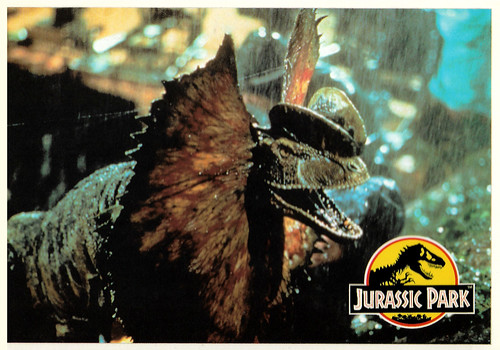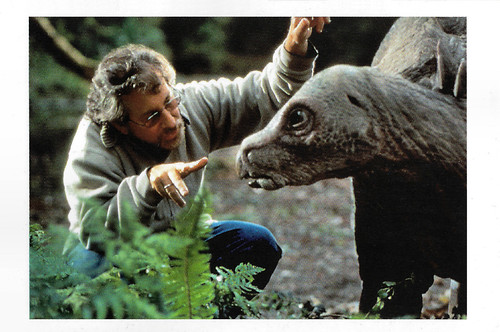
British postcard by Film Posters Merchandising, no. 869. Photo: UCS & Amblin. Joseph Mazzello and Sam Neill in Jurassic Park (Steven Spielberg, 1993).

British postcard by Film Posters Merchandising, no. 871. Photo: UCS & Amblin. Joseph Mazzello in Jurassic Park (Steven Spielberg, 1993).
During a control visit, things get completely out of hand
The story of Jurassic Park (Steven Spielberg, 1993) is about billionaire John Hammond (Richard Attenborough) who with the help of a team of genetic scientists, has managed to recreate prehistoric dinosaurs from their DNA.
On Isla Nublar, a fictional island off the coast of Costa Rica, he has concocted a wildlife park full of living dinosaurs, Jurassic Park (called after the geological era Jura).
After a Velociraptor attacks and kills one of the employees while she is being placed in her enclosure, the investors want to have the park's security checked before the official opening.
Hammond wants approval as soon as possible, so persuades palaeontologist Alan Grant (Sam Neill) and paleobotanist Ellie Sattler (Laura Dern) to spend a weekend in his park. Their mission is to show that everything is okay.
The lawyer Donald Gennaro (Martin Ferrero) and the chaos theory expert Ian Malcolm (Jeff Goldblum) also join. Hammond invites them along with his two grandchildren (Joseph Mazzello and Ariana Richards), to join him for a control visit before the official opening of Jurassic Park, but during this control visit, things get entirely out of hand.
Dennis Nedry (Wayne Knight), the park's computer technician, attempts to steal embryos from all the animals in the park for the competing company Biosyn and shuts the critical security systems down. For Hammond and his guests, it now becomes a race for survival with dinosaurs roaming freely over the island.

British postcard by Film Posters Merchandising, no. 872. Photo: UCS & Amblin. Publicity still for Jurassic Park (Steven Spielberg, 1993).

British postcard by Film Posters Merchandising, no. 873. Photo: UCS & Amblin. Publicity still for Jurassic Park (Steven Spielberg, 1993).
Recordings of rutting and mating animals represent the sound of the dinosaurs
In October 1989, author Michael Crichton and producer Steven Spielberg had a talk about the screenplay for what would later become the television series ER. In addition, the conversation was also about Crichton's future novel 'Jurassic Park', and Spielberg already had the idea of a film adaptation at that time.
With the backing of Universal Studios, Spielberg acquired the rights for $1.5 million before its publication in 1990 The film was produced by Kathleen Kennedy and Gerald R. Molen. Crichton was hired for an additional $500,000 to adapt the novel for the screen.
The dinosaurs were created with groundbreaking computer-generated imagery by Industrial Light & Magic (ILM) and with life-sized animatronic dinosaurs built by Stan Winston's team.
Initially, Spielberg had intended not to release Jurassic Park until after Schindler's List. This order was reversed because the director of the Music Corporation of America (then the parent company of Universal Pictures), Sid Sheinberg, made it a condition of his approval of Schindler's List. Both films were released in 1993.
After 25 months of pre-production, filming started on 24 August 1992 on the Hawaiian islands of Kauai and Oahu. Hurricane Iniki made landfall during the shooting on Kauai. Some storm scenes were also recorded during this hurricane.
The sound effects that represent the sound of the dinosaurs were made by recordings of rutting and mating animals. Among other things, the Jack Russell terrier of an employee of the film was used for the sound of the Tyrannosaurus.
The Velociraptors are completely covered with scales in the film, as during the production of the film it was assumed that they actually looked like this in the past. The current theory that many dinosaurs had feathers was not widely accepted at the time 'Jurassic Park' was published. In the second sequel, Jurassic Park III, the appearance of the raptors has been slightly adapted to this by giving them some feathers on the head.

British postcard by Film Posters Merchandising, no. 875. Photo: UCS & Amblin. Publicity still for Jurassic Park (Steven Spielberg, 1993).

British postcard by Film Posters Merchandising, no. 876. Photo: UCS & Amblin. Publicity still for Jurassic Park (Steven Spielberg, 1993).
You want great dinosaurs, you got great dinosaurs
Jurassic Park (1993) won all three Oscars for which the film was nominated: the Academy Award for Best Sound Editing, the Academy Award for Best Sound, and the Academy Award for Best Visual Effects.
At AllMovie, Brendon Hanley writes: "One of the most influential special effects movies of the early 1990s, Steven Spielberg's Jurassic Park helped show the world that the future of cinema was inside a computer. With digital dinosaurs courtesy of George Lucas' Industrial Light and Magic, the film helped redefine the summer blockbuster for a new generation."
Roger Ebert in the Chicago Sun-Times: "Jurassic Park throws a lot of dinosaurs at us, and because they look terrific (and indeed they do), we're supposed to be grateful. I have the uneasy feeling that if Spielberg had made Close Encounters today, we would have seen the aliens in the first 10 minutes, and by the halfway mark they'd be attacking Manhattan with death rays. Because the movie delivers on the bottom line, I'm giving it three stars. You want great dinosaurs, you got great dinosaurs.
Spielberg enlivens the action with lots of nice little touches; I especially liked a sequence where a smaller creature leaps suicidally on a larger one, and they battle to the death. On the monster movie level, the movie works and is entertaining. But with its profligate resources, it could have been so much more."
Jurassic Park went on to gross over $912 million worldwide in its original theatrical run, becoming the highest-grossing film of 1993 and the highest-grossing film ever at the time, until this title was taken over by Titanic in 1997.
Five sequels have been made or are in the works: The Lost World: Jurassic Park (Steven Spielberg, 1997), Jurassic Park III (Joe Johnston, 2001), Jurassic World (Colin Trevorrow, 2015), Jurassic World: Fallen Kingdom (Juan Antonio Bayona, 2018), and Jurassic World: Dominion (Colin Trevorrow, scheduled for a 2022 release). Although Spielberg did not direct the last four films in the series, he always remained involved as a producer.
Following its 3D re-release in 2013 to celebrate its 20th anniversary, Jurassic Park became the seventeenth film in history to surpass $1 billion in ticket sales. In 2018, the film was selected for preservation in the United States National Film Registry by the Library of Congress as being "culturally, historically, or aesthetically significant".

British postcard by Film Posters Merchandising, no. 874. Photo: UCS & Amblin. Jeff Goldblum in Jurassic Park (Steven Spielberg, 1993).

French postcard. Photo: Sygma. Caption: Steven Spielberg during the shooting of The Lost World - Jurassic Park (1996).
Sources: Brendon Hanley (AllMovie), Roger Ebert, Wikipedia (Dutch and English), and IMDb.
This post was last updated on 28 May 2022.
No comments:
Post a Comment